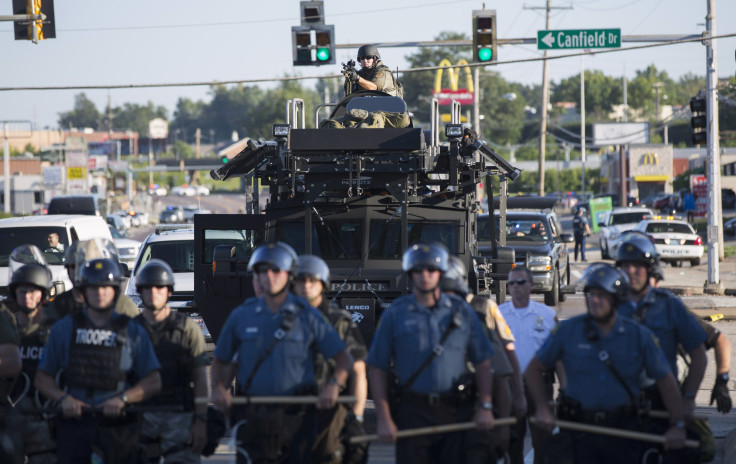Ferguson Police Militarization: Cash Flowed To Lawmakers Who Voted To 'Militarize' Police

As local law enforcement has deployed martial tactics against those protesting the police killing of an 18-year-old in Ferguson, Missouri, a debate is suddenly raging over how municipal police forces came to resemble military units. A new report suggests the trend may, in part, have to do with campaign contributions to congressional lawmakers.
At issue is the federal government’s so-called 1033 Program, which permits the Pentagon to give military hardware to local police departments.
In a June investigative report, the New York Times documented how that program, among others, has allowed police departments to “receive tens of thousands of machine guns; nearly 200,000 ammunition magazines; thousands of pieces of camouflage and night-vision equipment; and hundreds of silencers, armored cars and aircraft.” Newsweek notes that the program originally started in 1990 as part of the so-called War on Drugs, the idea being “that if the U.S. wanted its police to act like drug warriors, it should equip them like warriors, which it has — to the tune of around $4.3 billion in equipment.”
That represents potential profits for the defense contractors, because the program effectively creates a secondary market and additional demand for those contractors’ goods. The Pentagon can, for instance, pass equipment and ammunition to local police departments, only to then buy more equipment for itself. Meanwhile, those local police departments often spend money on parts and maintenance for the equipment, thereby providing another potential stream of money to the contractors. And once the department gets used to the surplus goods, there’s always the chance that the department itself becomes a direct buyer of those goods.
The group’s new report looked at a June congressional vote on legislation, offered by U.S. Rep. Alan Grayson, D-Fla., that would have blocked the Pentagon from spending resources on transferring military hardware to local police agencies. The bill was defeated 62-355.
According to data compiled by Maplight, the lawmakers “voting to continue funding the 1033 Program have received, on average, 73 percent more money from the defense industry than representatives voting to defund it.” In all, the average lawmaker voting against the bill received more than $50,000 in campaign donations from the defense industry in the last two years. The report also found that of the 59 lawmakers who received more than $100,000 from defense contractors in the last two years, only four voted for Grayson’s legislation.
Though thought of as a political force primarily in federal policymaking, the defense industry also spends on state politics, which influences law enforcement procurement decisions. According to data compiled by the National Institute for Money in State Politics, more than $8 million of campaign contributions has been dumped into state elections in the last decade by military contractors and their employees.
Police officials say the equipment helps them better secure local communities. By contrast groups such as the American Civil Liberties Union have recently launched a national campaign to demilitarize local police departments. That campaign got a boost this week when Republican Sen. Rand Paul of Kentucky, a prospective 2016 presidential candidate, published an editorial in Time magazine echoing the ACLU’s message in the wake of the Ferguson shooting.
“When you couple this militarization of law enforcement with an erosion of civil liberties and due process that allows the police to become judge and jury — national security letters, no-knock searches, broad general warrants, pre-conviction forfeiture — we begin to have a very serious problem on our hands,” he wrote.
© Copyright IBTimes 2025. All rights reserved.






















